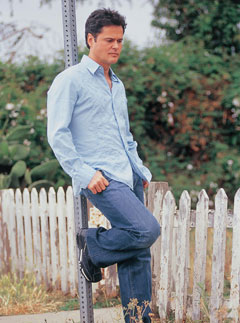


Donny Osmond is a 43-year music business veteran. He's sold 80 million records, and 33 of his 54 albums have gone gold. In addition to his work as a solo pop artist and member of the Osmonds, he's starred in hit musicals like Joseph and the Amazing Technicolor Dreamcoat.
This is one of the most complicated projects I've ever done. Thank goodness I know enough about the ins and outs of Nuendo and the 02R96V2.
But Osmond is more than just a successful entertainer--he's a music technology ace. We spoke with Donny backstage at the Lunt-Fontanne Theatre in New York, where he's playing the role of Gaston in the Broadway production of Beauty and the Beast while simultaneously recording vocals for a new album.
Playing the part of Gaston must be a blast.
It's so much fun--I'm having the time of my life! There's a lot of concentration, though. This one number takes place in the tavern, where we clink these beer mugs--it's highly choreographed, and it's so complicated that I thought I'd never get it. I remember seeing this number 12 years ago when the show debuted, and thinking, "Those poor dancers! How in the world did they learn that?" Little did I know someday I'd be learning it myself!

As a singer, what are the technical differences between performing in a Broadway role and doing a pop concert?
Projection and articulation. Those are the two keys that I learned through the six years of doing Joseph and the Amazing Technicolor Dreamcoat. You don't sing the same way. Plus, with Gaston, it's all dramatic anyway--he's basically a cartoon character come to life. I actually change my projection and my voice halfway through the show, when I go from playing this egotistical maniac to a creep! We each have lavalier mics; mine goes through my wig, which is funny in itself. But the way you work that mic in a theatrical situation is totally different from what you do with a hand mic in a pop concert.
And you're also working on a new record--your 55th!
It's going to be a '70s record. I've been trying to come up with a list of songs--it's hard, because there are so many cool songs that I want to redo my way. Mike Mangini is going to produce it for me; he did the last couple Joss Stone albums. I enjoy this process even more since I've become involved in the technical aspects of making records.
You've basically converted your dressing room at the theater into a vocal room.
Yes, I've shipped all my gear out from my home studio, and I'm putting up extra baffling and isolation elements. This room wasn't designed to be a vocal room! I'm trying to treat it as much as I can, but you might hear a taxi honk in the background.
And you'll be using a Yamaha 02R96V2. What do you like about that board?
First of all, the size. I can take it anywhere. I do a lot of the processing in Nuendo, so I use the O2R96V2 primarily as an interface. I originally got the board so I could work on the sound for the DVDs of The Donny and Marie Show, because of all the elements I had to bring together for that project.
What aspects of the sound did you work on for these DVDs?
Oh, it was more than just aspects, baby! [Laughs.] This is one of the most complicated projects I've ever done. Thank goodness I know enough about the ins and outs of Nuendo and the O2R96V2. I've always wanted to bring the old Donny and Marie shows out on DVD. But I had lost track of all the tapes. It took about ten years to track them down, but I eventually found 80% to 90% of the audio tapes for all four seasons. I got three Yamaha AW2400s so I could transfer the tracks without having FireWire throughput problems, and recorded eight tracks at a time into Nuendo at 48 kHz/24-bit. And that's not even getting into the sync issues!
What does Nuendo bring to the process for you?
Phil Ramone and Elliot Shiner got me into Nuendo when I recorded This Is the Moment with them. I love the ergonomics of Nuendo--it's so easy to use. When I was doing some bit rate conversions for The Donny and Marie Show, I had every single type of equipment at my disposal. And I wound up using Nuendo, because its algorithms are the best.
You've spent almost your entire life in the music business. What's changed the most?
People who can't sing can record now. I love technology, but people are using the gadgetry to make anybody sound good. For this album, I've been listening to a lot of the '70s stuff, and there were some great singers, some great songs--some real music. Music you could trust. When I listen to some music today, I don't trust the artist. I don't know if I'm listening to the producer or the artist.
And what aspects of the business are still the same?
A great song is still a great song! We used to say, "It's in the grooves." You can't replace a great melody, or a great hook, something that just stays in your mind.
























